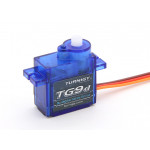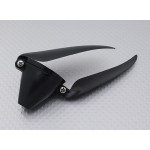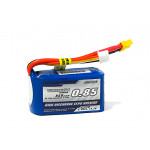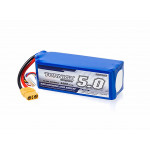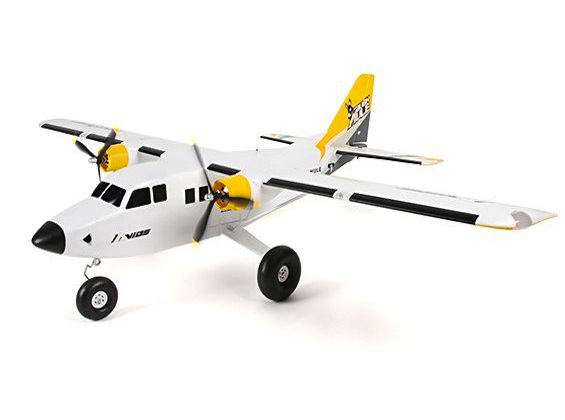
Written by gozerian
I fell in love with this airplane the moment that I pulled it out of the box. It was well packed and sealed to protect it during transport and this is important when you consider just how far a model has to travel to make it halfway around the world.
From the outset, the model looks well finished with expertly applied decals and paintwork. The model appears to be well constructed with a lot of thought put into keeping it light, yet still ensuring that it could handle the roughest of landing and come back for more. I was impressed with just how solid and forgiving this plane is.
Fuselage
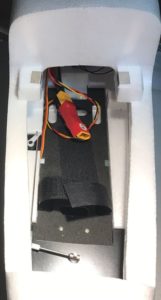 The fuselage is quite a solid frame with generous amounts of foam where it counts and the battery tray area is quite large with ample room for a 4S 3000-4000mah battery. The nose servo linkages are easy enough to access if required, and the fuselage is equipped with a rear door and side door. Although, I wish Avios had included a parachute man. The side door makes for easy access to the receiver and other related parts and the side hatch would be perfect for a flight controller.
The fuselage is quite a solid frame with generous amounts of foam where it counts and the battery tray area is quite large with ample room for a 4S 3000-4000mah battery. The nose servo linkages are easy enough to access if required, and the fuselage is equipped with a rear door and side door. Although, I wish Avios had included a parachute man. The side door makes for easy access to the receiver and other related parts and the side hatch would be perfect for a flight controller.
Landing Gear
The wheels remind me of the Durafly Tundra, although there appear to be subtle differences. They are still just as hardy as the Tundra wheels and as solid. The wheels are secured to the 4mm axle by a c-clip. The landing gear is solid and you’ll be happy with the rigidity. They have nailed the material here because it’s not brittle and it’s not soft. Perfect balance was struck here. The Aircraft taxis well and the large wheels give it the flexibility to take off and land in areas that are rough.
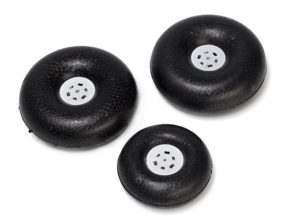 The nose wheel pivots in two plastic plates fixed to the top and bottom of the fuselage. During testing, I put the aircraft through its paces and after several poor landings, the gear was intact and undamaged. Avios did a great job with the landing gear and should be commended.
The nose wheel pivots in two plastic plates fixed to the top and bottom of the fuselage. During testing, I put the aircraft through its paces and after several poor landings, the gear was intact and undamaged. Avios did a great job with the landing gear and should be commended.
Floats
The floats are well-engineered with a hard plastic bonded to the foam skis. The aluminum struts have been reduced in height from the first photos that we saw and it does look very impressive on floats. I haven't had the chance to fly from the water yet but I fully intend to do that when time allows. I am sure I could use the floats on another project
Wing
The wing is made up of three pieces and they come together to make up an impressive 1500mm wingspan. Not too big and not too small, so it should be easy to transport around. The wings come together with four screws and two struts. The mid-wing is secured to the fuse via two locating tabs and held on with two m4 Philips head screws. The wing struts are well made and attach to the wing and fuse via a body clip. It is very easy to remove if required. The spar pieces are made of pressed aluminum and appear to be very solid. The foam would bend before the spar would.
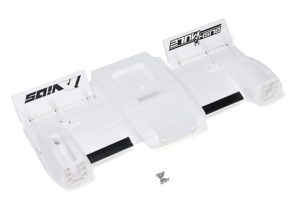 The Ailerons are a simple foam hinge with ample material for long serviceable life. The flaps are well made and use a fold-down hinge. They are quite effective and can considerably slow the aircraft down when deployed. The aircraft will nose up with flaps, so if your radio allows for it, add a small amount of down elevator.
The Ailerons are a simple foam hinge with ample material for long serviceable life. The flaps are well made and use a fold-down hinge. They are quite effective and can considerably slow the aircraft down when deployed. The aircraft will nose up with flaps, so if your radio allows for it, add a small amount of down elevator.
The plastic parts are well finished and appear to be quite stiff. Although I tend to prefer ball links, the included nylon clevis are good quality and quite up to the task. The control horns are also nylon and again, no complaints here. They are secured with M2 bolts through the control surface and into the retainer plate on the other side. The hinges on the flaps are made of the same plastic as the rest of the wing.
Motors
The motors are pre-installed into the main wing section and surrounded by a plastic cowl. The motors are reasonable quality and well finished. The prop is a simple paddle blade-style 3 blade arrangement and is secured with nuts onto a 3mm shaft. The motors spin in different directions (CCW & CW) like many full-size twin-engine aircraft, and this assists in canceling torque roll and making for a nicer flying aircraft. The motors are two motors are 3536 850kv running on a 4S setup.
ESC
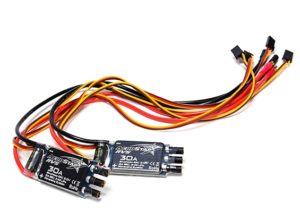 The Bushmule has Aerostar ESCs fitted, judging by previous ESC’s in this range, they are very reliable. I found no issues whilst I was giving the plane the right flogging. Excellent linear throttle curve with smooth range. The ESCs come pre-fitted with a neat wire loom ready for installation. A 4amp BEC is fitted to the ESC to power the receiver and servos.
The Bushmule has Aerostar ESCs fitted, judging by previous ESC’s in this range, they are very reliable. I found no issues whilst I was giving the plane the right flogging. Excellent linear throttle curve with smooth range. The ESCs come pre-fitted with a neat wire loom ready for installation. A 4amp BEC is fitted to the ESC to power the receiver and servos.
Flight Report
- From the outset, it is a great plane to fly and will make for an excellent FPV platform.
- Take off is very simple and little effort is required. Take off is anywhere from 50% to 100% throttle and the flap is not required.
- The most efficient flight was around 50% throttle.
- Flap caused the nose to lift, however as you reduce the power it is less profound, and a little elevator mix will elevate this.
- The rudder is very responsive and you may find reducing the travel and expo make for cleaner rudder input.
- The aircraft has no issue with loops, rolls, and even a snap roll was executed during my test flights.
- Landings do not require flaps. If you intend to use flaps I suggest you test them up high and set them up properly before attempting a landing.
- You will be able to fly quite slowly with flaps deployed but they are not needed to land.
- Landing requires no special skill. Start by reducing throttle and holding the nose of the aircraft slightly up.
- As you reduce throttle, the aircraft will descend, and if you want to slow the decent apply a little more throttle.
- Generally, you will need to land with throttle however I did dead stick the aircraft in as well. The CG I used was as per the manual
Hear it First: Join our Mailing List
Sign up to receive new product updates, exclusive discounts, news, and more!

